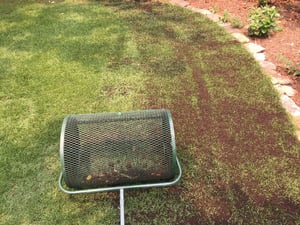The soil on top
|
Upon first thought, it seems somewhat absurd to spread a layer of compost or sand over your grass. After all, dirt is supposed to be under the grass. This is what topdressing a lawn is, though, and knowing the benefits and how to do it is the first step in this organic lawn care strategy. Buy 100% Organic Nova Scotia Made Top Dressing Compast Here! Topdressing a lawn is accomplished by spreading a thin layer of material such as compost or sand over the grass. This practice dates back to when golf was first invented in Scotland and is gaining popularity with homeowners transitioning to organic lawn care. |
 |
Benefits of Topdressing a Lawn
When the soil under your grass starts to lose its oomph, or it’s a new lawn that isn’t doing well, pulling all of the grass up to amend it isn’t a feasible option. Topdressing is a simpler — albeit still challenging — way to see the following benefits in your lawn.
- Adds organic matter to the topsoil, improving poor soil by enhancing its productive properties
- Improves the soil structure, water holding capacity, and cation exchange capacity
- Builds up beneficial soil microbes
- Reduces thatch
- Smooths out uneven terrain from worm castings, freeze/thaw cycle, or water runoff
- Reduces the need for fertilizing
|
Compost Spreader
|
What Topdressing Material to Use?One of the first and most important steps is deciding what type of topdressing material you should use. To be effective and advantageous, it needs to be similar in texture to the underlying soil. Choosing the wrong material can create serious problems. According to the late James Beard, a leading authority on turfgrass: “[O]ne of the most important considerations in topdressing is the use of a soil mixture of comparable texture and composition to the underlying soil … The use of topdressing mixes containing textures drastically different from the underlying soil results in the development of a distinct layer that impairs air and water movement considerably and results in an overall reduction of turfgrass quality.” The most common options are sand, topsoil similar to your existing soil, high-quality compost, or a custom-blended mix of the materials. |
- Sand is used extensively on golf courses, primarily on man-made greens. It can also be used with heavy clay soils to improve drainage. Avoid using fine sand over coarse-textured soil.
- Topsoil similar to the existing soil structure is acceptable and will help smooth out the ground but doesn’t contain much organic material.
- Compost is the most recommended material to use, as long as it is finished and has few fillers.
- It is common for homeowners to use a mix of the above materials to create a cost-effective blend that is comparable to their existing soil. Most often, a blend of compost and either topsoil/sand is recommended.
Tips for Topdressing Your Lawn
Topdressing your lawn can be a DIY project, but truthfully it is a very labor-intensive endeavor. Some home improvement centers have motorized spreader machines available for rent which will reduce the labor but increase the cost.
- Routine topdressing improves thatch breakdown and improves the soil. However, it does raise the grade of your yard. To ensure you don’t raise it too much, it’s best not to topdress your entire lawn routinely. Treat bare spots as needed and the entire lawn every few years.
- Topdress the lawn more often: A very light topdressing application can be completed more often if the amount added is shallow enough to be brushed into aeration holes.
- Time according to your grass type. Topdress lawns in the spring for warm-season grasses and in the fall for cool-season grasses. This allows three or four mows before severe heat or cold sets in.
- Combine with other cultural practices like overseeding to grow new grass.
If topdressing your lawn yourself sounds like too big of a project to tackle yourself, some lawn care companies offer topdressing services to clients. It’s becoming a more popular service available because of demand but is still not widely available; it requires a lot of work with a small profit margin for companies.
How to Topdress Your Lawn in 7 Steps
As a DIY project, the process isn’t difficult. It is tedious and labor-intensive, however.
- Check the soil pH and adjust accordingly if it is out of range.
- Open up the thatch layer with a power rake or aerator to create channels for the topdressing material to penetrate the surface.
- Mow grass as short as possible without stressing it to the point of damage.
- Remove grass clippings, dethatching debris, or plugs of soil from aerating.
- Spread grass seed if overseeding.
- Shovel out a small amount of your material, working in small areas, a few square feet at a time. Using your shovel, “fling” the materials with a smooth, sweeping motion similar to hitting a hockey puck, spreading the topdressing over the lawn to a depth of ⅛ to ½ inch. Fertile, rapidly growing turf and lawns that are more prone to thatch may require heavier topdressing rates.
- Gently rake it in or water the lawn well. That moves material down to the soil surface.
Once you have successfully topdressed your yard, now it’s time to be patient, as it can take a few seasons to see the full results. If done correctly, you will see improvements in drainage and water retention quickly, but it takes time for the microbes to start working and the organic matter to begin breaking down.
